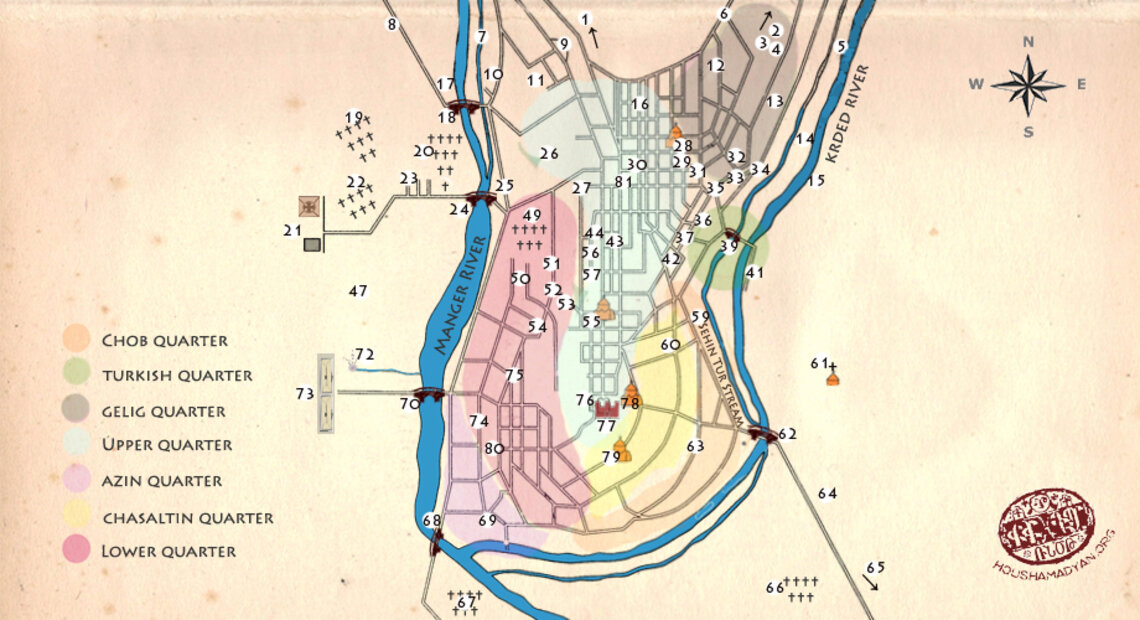Hadjin
The town of Hadjin:
1. Torp Babug Quarter/ 2. American Girl’s School/ 3. St. Arakel/ 4. St. Varvar/ 5. Source / 6. Bezbez Fountain/ 7. Gardens/ 8. Cheshbeg Road/ 9. Ghangle Bazaar/ 10. Divanyol/ 11. Hannes Quarter/ 12. Gelig Quarter/ 13. Krded Road/ 14. Gardens/ 15. Krded River/ 16. Manger Quarter/ 17. Manger River/ 18. Zebe Bridge/ 19. Penudnun Cemetery/ 20. Old Cemetery/ 21. St. Hagop Monastery and Orphanage/ 22. St. Hagop Cemetery/ 23. Bahchedji/Bahçeci Quarter/ 24. Monastery’s Bridge/ 25. Monastery’s Mill/ 26. Ellez Slope/ 27. Soghlan Fountain/ 28. Protestant 1st Church/ 29. Ghram Quarter/ 30. Seksen Fountain/ 31. Eredjeb Fountain/ 32. Ghopush Quarter/ 33. Ghaytandj Fountain/ 34. Manes Khan/ 35. Public bath/ 36. Bath’s Fountain/ 37. Kalender Quarter/ 38. Mosque/ 39. Tannery Bridge/ 40. Sehin Tur Stream/ 41. Tannery/ 42. Chatlekh/ 43. Bughda Bazaar/ 44. City Hall/ 45. Melek Girmez Charchese/Çarçısı/ 46. Great Market/ 47. Monastery’s Fields/ 48. Gardens/ 49. Sesunts Cemetery/ 50. Sesunts Quarter/ 51. Sesunts Hole/ 52. Telesem Quarter/ 53. Telesem Fountain/ 54. Sesunts Fountain/ 55. Chatholic Church and School/ 56. Millet Khan/ 57. St. Kevork Church and School/ 58. Socrat Fountain/ 59. Chandetnun Quarter/ 60. Protestant College/ 61. St. Yeghya/ 62. Chob Bridge/ 64. St. Sarkis Road/ 65. St. Sarkis Cemetery/ 66. Arm. Catholic Cemetery/ 67. Chander Cemetery/ 68. Bahadur Mill/ 69. Government Building (konak)/ 70. Akhelin Mill/ 71. Burukh Bridge/ 72. White Fountain/ 73. Barracks/ 74. St. Toros Church and School/ 75. Uzun Oglan Fountain/ 76. Girl’s School/ 77. Citadel/ 78. St. Asdvadzadzin Church/ 79. Protestant 2nd Church/ 80. Yazevo Market/ 81. Market’s Fountain
Houshamadyan column
There is a rich source bibliography regarding Hadjin (present-day Saimbeyli) in Armenian historiography. Most of the books written about this prominent Cilician Armenian town either deal with the fedayee (partisan) movement or the 1920 resistance battles, ending in an Armenian defeat and massacre. Otherwise, the sources are scare when it comes to the general social situation of Hadjin Armenians.
Luckily, even this scarcity is a monumental work whose author is H. B. Boghosian. His manuscript, Hadjno enthanour batmutyune yev shrchaga Kozan-Daghi hay kyughere [General history of Hadjin and the neighboring Kozan-Dagh Armenian villages], was published in Los Angeles, 1942. In its around 850 pages, the author presents various facets of life in his native town. Thus, the texts prepared by Houshamadyan regarding Hadjin are principally based on this firsthand source.
If our readers know of the existence of additional materials about Hadjin, we kindly request that they send them to our email address (houshamadyan@gmail.com). Such cooperative effort will allow us to reconstruct the former Armenian life of Hadjin and the overall local inheritance created there in the best possible manner. Such material can include memoirs (published or not), oral testimonies, old photos, items brought from Hadjin, etc.
